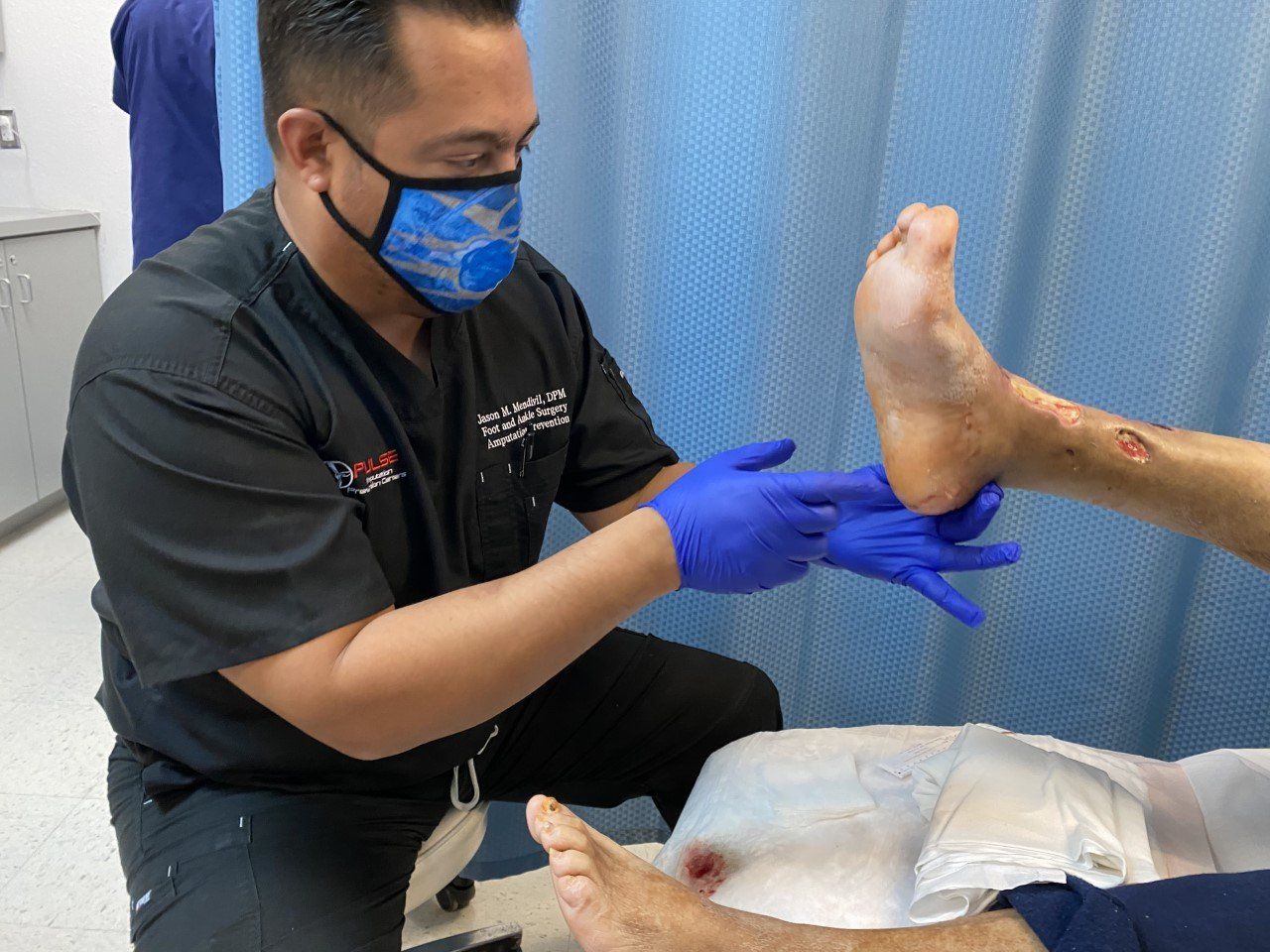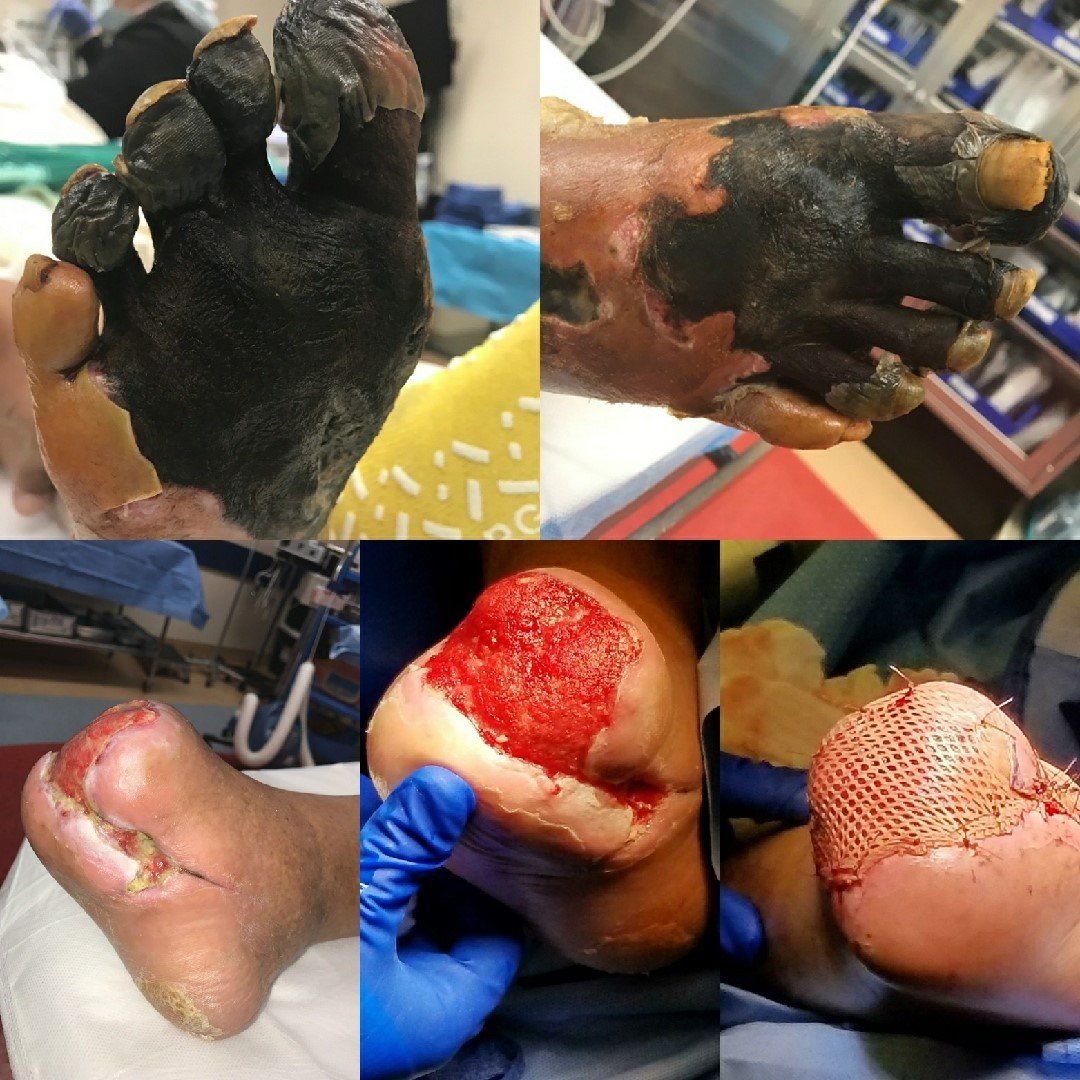Information for Patients
What is PAD – Peripheral Artery Disease?
Peripheral Artery Disease also known as PAD is the narrowing of peripheral arteries due to atherosclerosis (plaque buildup on arterial walls) and decreases blood flow to your legs, feet, and toes. PAD left untreated has serious complications to include critical limb ischemia, gangrene, and amputation.
Peripheral Artery Disease (PAD) is a quite common condition yet serious condition that needs to be talked about and while medical intervention is often not necessary, medically required treatments cannot be postponed. There are multiple risk factors that greatly increase the likelihood of someone developing Peripheral Artery Disease are increasing age, obesity, high blood pressure, high cholesterol, smoking, diabetes, neuropathy, and a cold leg / foot. PAD symptoms may include but are not limited to leg pain/cramps, numbness, tingling, non-healing foot wounds, and or skin discoloration. Then you have some that show no symptoms all while the plaque is silently circulating your system and increasing your risk for stroke and amputation. PAD symptoms are easily overlooked if attributed to arthritis and old age or when masked by nerve damage and peripheral neuropathy. African Americans and Native Americans are at particularly high risk for Peripheral Artery Disease.
PAD is a chronic disease and is often misconstrued as acute and that is why follow up is important and knowing the signs and symptoms are especially important. In its late form, patients with PAD may suffer from pain and non-healing wounds, which can increase the risk of infection and amputation. After an amputation, there is a 5-year mortality rate of 50%. Which we are just YELLING all the time that 50 % of all amputations period are preventable to begin with. Early detection of PAD is critical and can be lifesaving. Please be proactive in your life and If you have symptoms of PAD or fall into a higher risk group (please see question about risk factors below), you are strongly recommended to come in for an evaluation.
What is PAD – Peripheral Artery Disease?
Peripheral Artery Disease also known as PAD is the narrowing of peripheral arteries due to atherosclerosis (plaque buildup on arterial walls) and decreases blood flow to your legs, feet, and toes. PAD left untreated has serious complications to include critical limb ischemia, gangrene, and amputation.
Peripheral Artery Disease (PAD) is a quite common condition yet serious condition that needs to be talked about and while medical intervention is often not necessary, medically required treatments cannot be postponed. There are multiple risk factors that greatly increase the likelihood of someone developing Peripheral Artery Disease are increasing age, obesity, high blood pressure, high cholesterol, smoking, diabetes, neuropathy, and a cold leg / foot. PAD symptoms may include but are not limited to leg pain/cramps, numbness, tingling, non-healing foot wounds, and or skin discoloration. Then you have some that show no symptoms all while the plaque is silently circulating your system and increasing your risk for stroke and amputation. PAD symptoms are easily overlooked if attributed to arthritis and old age or when masked by nerve damage and peripheral neuropathy. African Americans and Native Americans are at particularly high risk for Peripheral Artery Disease.
PAD is a chronic disease and is often misconstrued as acute and that is why follow up is important and knowing the signs and symptoms are especially important. In its late form, patients with PAD may suffer from pain and non-healing wounds, which can increase the risk of infection and amputation. After an amputation, there is a 5-year mortality rate of 50%. Which we are just YELLING all the time that 50 % of all amputations period are preventable to begin with. Early detection of PAD is critical and can be lifesaving. Please be proactive in your life and If you have symptoms of PAD or fall into a higher risk group (please see question about risk factors below), you are strongly recommended to come in for an evaluation.
Signs and Symptoms of Peripheral Artery Disease
- Foot or lower extremity ulcer/wound/gangrene
- Cool/cold foot
- Pale/ Discolored/mottled foot or leg
- In conjunction with the above 3:
- Severe leg or foot pain of new/sudden onset
- Pain walking < 20 feet
Are You at Risk?
- Are you over age 50?
- Do you smoke or used to smoke?
- Do you have diabetes?
- Do you have high blood pressure?
- Do you have high blood cholesterol?
- Are you African American?
When to call us for new wound or changes to your foot:
- Foot or lower extremity ulcer/wound/gangrene
- Cool/cold foot
- Pale/ discolored /mottled foot or leg
- Severe leg or foot pain of new/sudden onset
- Pain walking < 20 feet
When to call us for existing wounds or PAD changes:
- New drainage noted to wound
- Redness and warmth around affected area
- Yellow or green pus
- A foul smell
- Red or Brown discoloration
- New or increased pain
- Increased difficulty walking
If you have a wound and are experiencing any of these symptoms please call us immediately for an urgent appointment or telemedicine consult. We will see you within 24 hours.
If you are experiencing any of these Signs & Symptoms call:
The Amputation Prevention/CLI Hotline 915-243- FOOT (3668) or (915) 532-6767
If you must go to the Hospital Please Go to The Hospitals of Providence Memorial Campus- 2001 N. Oregon 915-577-6011
Critical Limb Ischemia
Critical Limb Ischemia (CLI) is a severe obstruction of the arteries which markedly reduces blood flow to the extremities (hands, feet, and legs) and has progressed to the point of severe pain and even skin ulcers or sores. The pain caused by CLI can wake up an individual at night. This pain, also called "rest pain", is often in the leg and can be relieved temporarily by hanging the leg over the bed or getting up to walk around.
- CLI is a very severe condition of peripheral artery disease (PAD) and needs comprehensive treatment by a vascular surgeon or vascular specialist. This condition will not improve on its own.
Causes
- Critical limb ischemia is the advanced stage of peripheral artery disease (PAD), which results from a progressive thickening of an artery's lining (caused by a buildup of plaque). This buildup of plaque, also known as atherosclerosis, narrows or blocks blood flow, reducing circulation of blood to the legs, feet, or hands.
Risk Factors
- The risk factors for critical limb ischemia include:
- Age (Men over 60 and women after menopause)
- Smoking
- Diabetes
- Overweight or obesity
- Sedentary lifestyle
- High cholesterol
- High blood pressure
- Family history of vascular disease
Warning Signs
- You may have critical limb ischemia if you have any of the following symptoms:
- Severe pain or numbness in the legs and feet while not moving
- A noticeable decrease in the temperature of your lower leg or foot compared to the rest of your body
- Toe or foot sores, infections, or ulcers that will not heal, or heal very slowly
- Gangrene
- Shiny, smooth, dry skin in the legs or feet
- Thickening of the toenails
- Absent or diminished pulse in the legs or feet
Symptoms
- Pain or numbness in the feet.
- Shiny, smooth, dry skin of the legs or feet.
- Thickening of the toenails.
- Absent or diminished pulse in the legs or feet.
- Open sores, skin infections or ulcers that will not heal.
- Dry gangrene (dry, black skin) of the legs or feet.
Hispanics are at higher risk:
•Minorites had both a higher incidence and proportion of diabetes-related LOWER EXTREMITY AMPUTATION (LEA), compared with non-Hispanic whites.”
•Mexican Americans had MORE diabetes-related amputation, 85.95% than blacks or non-Hispanic whites 74.7% & 56.3% respectively
•The risks for major amputation were significantly higher… in Hispanic patients with Diabetic Foot Infections (DFIs) compared to White patients2
Spanish/Español
Signos y síntomas de Peripheral Artery Disease/ Critical Limb Ischemia/Infección de heridas- Llame al 915-243-3668
¿Qué es Peripheral Artery Disease?
Enfermedad Arterial Periférica(P.A.D.) es una enfermedad común pero grave. P.A.D. ocurre cuando el colesterol y la grasa adicionales que circulan en la sangre se acumulan en las paredes de las arterias que suministran sangre a las extremidades. P.A.D. puede afectar su calidad de vida, dificultar el caminar, conducir a heridas no curativas o peor, aumentar el riesgo de ataque cardíaco, accidente cerebrovascular, amputación de piernas, e incluso la muerte.
¿Estás en riesgo?
- ¿Tiene más de 50 años?
- ¿Fuma o fuma?
- ¿Tiene diabetes?
- ¿Tiene presión arterial alta?
- ¿Tiene colesterol alto en la sangre?
- ¿Eres afroamericano?
- ¿Tiene antecedentes personales de enfermedad vascular, ataque cardíaco o accidente cerebrovascular?
Cuándo llamarnos para una nueva herida o cambios en su pie:
- Úlcera/herida/gangrena en el pie o en la extremidad inferior
- Pie frío/frío
- Pie o pierna pálido/decolorado/moteado
- Dolor intenso en la pierna o en el pie de inicio nuevo/repentino
- Dolor caminando < 20 pies
Cuándo llamarnos para las heridas existentes o cambios de PAD:
- Nuevo drenaje observado para herida
- Enrojecimiento y calidez alrededor de la zona afectada
- Pus amarillo o verde
- Un olor fétido o fuerte de la herida
- Decoloración roja o marrón
- Dolor nuevo o aumentado
- Aumento de la dificultad para caminar
Si usted tiene una herida y está experimentando cualquiera de estos síntomas por favor llámenos inmediatamente para una cita urgente o consulta de telemedicina. Nos vemos en un plazo de 24 horas
Si usted está experimentando cualquiera de estos signos y síntomas llame:
La Linea de prevención de amputación/CLI Hotline
Si debe ir al Hospital Por favor vaya a
The Hospitals of Providence Memorial Campus- 2001 N. Oregon
CONTACT INFORMATION
PHONE:
ADDRESS:
4301 N. Mesa Ste . 100
El Paso Texas 79902
2311 N Oregon St
5th Floor El Paso, TX 79902
OUR LOCATION



